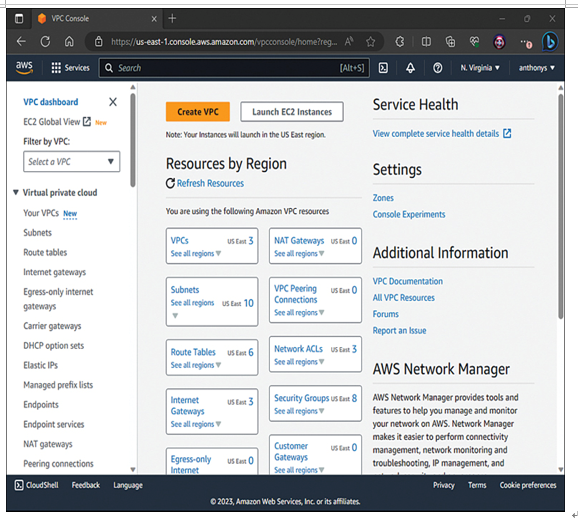Network Services
Where would we be without networks? Well, back to the Sneakernet, I suppose (the days when employees in offices would carry disks from desk to desk as a method of transferring data). Thanks to modern advancements in networking, the cloud is now possible. Here are some of the critical networking services we discuss in this text:
Virtual Private Cloud (VPC): AWS VPC lets you provision a logically isolated section of the AWS Cloud where you can launch AWS resources in a virtual network that you define. You have complete control over your virtual networking environment, including the selection of your IP address range, creation of subnets, and configuration of route tables and network gateways. You can use both IPv4 and IPv6 in VPCs for secure and easy access to resources and applications. Figure 1-5 shows elements inside a VPC.

Figure 1-5 Components of an AWS VPC
Route 53: AWS Route 53 is a highly available and scalable cloud Domain Name System (DNS) web service. Route 53 effectively directs user requests to infrastructure running in AWS—such as EC2 instances, Elastic Load Balancing load balancers, or S3 buckets—and can also be used to route users to infrastructure outside of AWS. You can use Route 53 to configure DNS health checks to route traffic to healthy endpoints or to monitor the health of an application and its endpoints independently. Of course, AWS also acts as a domain registrar, so it handles the details when you need to establish and host a new domain name. In fact, you can even host a website in an AWS S3 bucket for as little as pennies per month. Having a website hosted from a simple S3 bucket is yet another example of serverless compute capabilities in the AWS Cloud.
CloudFront: AWS CloudFront is a global content delivery network (CDN) service. It accelerates delivery of your websites, APIs, video content, or other web assets. The service automatically routes requests for your content to the nearest edge location, so it delivers content with the best possible performance. If you are hosting websites in S3 buckets as described earlier, you can secure them (using HTTPS) and make them globally available for low-latency access, thanks to CloudFront.
API Gateway: AWS API Gateway is a fully managed service that makes it easy for developers to create, publish, maintain, monitor, and secure APIs at any scale. With a few clicks in the AWS Management Console, you can create an API that acts as a “front door” for applications to access data, business logic, or functionality from your back-end services, such as workloads running on EC2, code running on AWS Lambda, or any web application.
Direct Connect: AWS Direct Connect is a solution that makes it easy to establish a dedicated network connection from your premises to AWS. Using AWS Direct Connect, you can establish private connectivity between AWS and your private network. In many cases, AWS Direct Connect can reduce your network costs, increase bandwidth throughput, and provide a more consistent network experience than Internet-based connections. Note that while I indicate that it can reduce your network costs, AWS Direct Connect is not free. It might, however, help you reduce expenditures by replacing a more costly connection you might have now.
